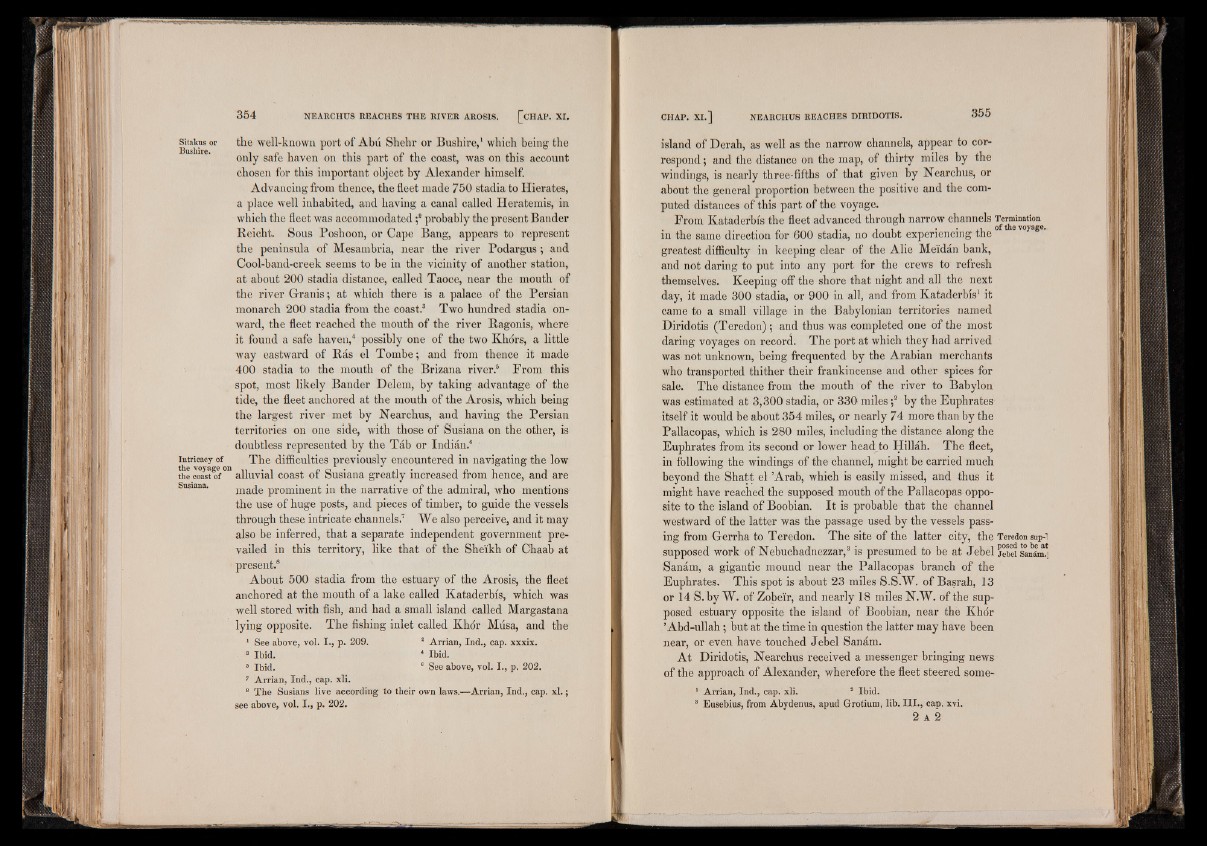
Sitakus or
Bushire.
Intricacy of
the voyage c
the coast of
Susiana.
the well-known port of Abu Shehr or Bushire,1 which being the
only safe haven on this part of the coast, was on this account
chosen for this important object by Alexander himself.
Advancing from thence, the fleet made 750 stadia to Hierates,
a place well inhabited, and having a canal called Heratemis, in
which the fleet was accommodated ;8 probably the present Bander
Keicht. Sous Poshoon, or Cape Bang, appears to represent
the peninsula of Mesambria, near the river Podargus; and
Cool-band-creek seems to be in the vicinity of another station,
at about 200 stadia distance, called Taoce, near the mouth of
the river Granis; at which there is a palace of the Persian
monarch 200 stadia from the coast.3 Two hundred stadia onward,
the fleet reached the mouth of the river Bagonis, where
it found a safe haven,4 possibly one of the two Khors, a little
way eastward of Bas el Tombe; and from thence it made
400 stadia to the mouth of the Brizana river.6 From this
spot, most likely Bander Delem, by taking advantage of the
tide, the fleet anchored at the mouth of the Arosis, which being
the largest river met by Nearchus, and having the Persian
territories on one side, with those of Susiana on the other, is
doubtless represented by the Tab or Indian.6
The difficulties previously encountered in navigating the low
alluvial coast of Susiana greatly increased from hence, and are
made prominent in the narrative of the admiral, who mentions
the use of huge posts, and pieces of timber, to guide the vessels
through these intricate channels.7 We also perceive, and it may
also be inferred, that a separate independent government prevailed
in this territory, like that of the Sheikh of Chaab at
present.6
About 500 stadia from the estuary of the Arosis, the fleet
anchored at the mouth of a lake called Kataderbis, which was
well stored with fish, and had a small island called Margastana
lying opposite. The fishing inlet called Khbr Musa, and the
1 See above, vol. I p. 209. 8 Arrian, Ind., cap. xxxix.
8 Ibid. 4 Ibid.
5 Ibid. 6 See above, vol. I., p. 202.
7 Arrian, Ind., cap. xli.
8 The Susians live according to their own laws.—Arrian, Ind., cap. x l . ;
see above, vol. I., p. 202.
island of Derah, as well as the narrow channels, appear to correspond
; and the distance on the map, of thirty miles by the
windings, is nearly three-fifths of that given by Nearchus, or
about the general proportion between the positive and the computed
distances of this part of the voyage.
From Kataderbis the fleet advanced through narrow i channels Temination in the same direction for 600 stadti a, no di ouib it experiencing jt.hi eof the voyage,
greatest difficulty in keeping clear of the Alie Mei'dan bank,
and not daring to put into any port for the crews to refresh
themselves. Keeping off the shore that night and all the next
day, it made 300 stadia, or 900 in all, and from Kataderbis1 it
came to a small village in the Babylonian territories named
Diridotis (Teredon); and thus was completed one of the most
daring voyages on record. The port at which they had arrived
was not unknown, being frequented by the Arabian merchants
who transported thither their frankincense and other spices for
sale. The distance from the mouth of the river to Babylon
was estimated at 3,300 stadia, or 330 miles ;2 by the Euphrates
itself it would be about 354 miles, or nearly 74 more than by the
Pallacopas, which is 280 miles, including the distance along the
Euphrates from its second or lower head to Hillah. The fleet,
in following the windings of the channel, might be carried much
beyond the Shatt el ’Arab, which is easily missed, and thus it
might have reached the supposed mouth of the Pallacopas opposite
to the island of Boobian. It is probable that the channel
westward of the latter was the passage used by the vessels passing
from Gerrha to Teredon. The site of the latter city, the Teredon sup-1
supposed work of Nebuchadnezzar,3 is presumed to be at Jebel j°bei Sanlm*
Sanam, a gigantic mound near the Pallacopas branch of the
Euphrates. This spot is about 23 miles S.S.W. of Basrah, 13
or 14 S. by W. of Zobei'r, and nearly 18 miles N.W. of the supposed
estuary opposite the island of Boobian, near the Khor
’Abd-ullah; but at the time in question the latter may have been
near, or even have touched Jebel Sanam.
At Diridotis, Nearchus received a messenger bringing news
of the approach of Alexander, wherefore the fleet steered some-
1 Arrian, Ind., cap. xli. 8 Ibid.
3 Eusebius, from Abydenus, apud Grotium, lib. I I I ., cap. xvi.
2 A 2